 Cold Vapor Atomic Absorption Spectroscopy or CVAAS is one of the primary techniques for mercury analysis. Introduced in 1968 by Hatch and Ott, CVAAS is now the reference method for drinking water monitoring under the Safe Drinking Water Act passed in 1974, and amended in 1986 and 1996. The technique was introduced to the market following the first commercially available atomic absorption spectrometer, which measures quantities of chemical elements present in environmental samples.
Cold Vapor Atomic Absorption Spectroscopy or CVAAS is one of the primary techniques for mercury analysis. Introduced in 1968 by Hatch and Ott, CVAAS is now the reference method for drinking water monitoring under the Safe Drinking Water Act passed in 1974, and amended in 1986 and 1996. The technique was introduced to the market following the first commercially available atomic absorption spectrometer, which measures quantities of chemical elements present in environmental samples.
Atomic Absorption Spectrometry (AAS) determines the quantities by “measuring the absorbed radiation by the chemical element of interest. This is done by reading the spectra produced when the sample is excited by radiation.”[i] CVAAS was born when Hatch and Ott used an attachment for a flame atomic absorption spectrophotometer that enabled the reduction of Hg2+ in a solution to ground state atoms (Hg0). The ground-state mercury atoms were then transported to an optical cell and detector for measurement. Shortly after Hatch and Ott introduced the technique to the market, the United States EPA adopted CVAAS for the determination of mercury in water, soil and fish.
The early CVAAS systems provided:
- Detection limits in the single-digit part per trillion range (ng/L)
- A linear dynamic range of 3 to 4 orders of magnitude
- An abundance of analytical methods designed to determine the mercury concentration in almost any sample matrix
Today’s CVAAS systems are more sensitive, automated, smaller, faster and less expensive than the early generic flame spectrometers with the cold vapor attachments. Modern models provide trace to ultra-trace detection limits of ng/L and can analyze samples in a minute. The systems also do not require a lot of operator interaction or bench space.
Most CVAAS instruments have a peristaltic pump that transports sample and stannous chloride into a Gas Liquid Separator (GLS) where a stream of pure, dry gas (typically argon) is introduced to the liquid mixture to release mercury vapor. Gas carries the mercury in the vapor phase through a dryer and into an atomic absorption optical cell. Once in the absorption cell, the elemental mercury will absorb light at 253.7 nm in logarithmic proportion to its actual concentration in the sample. Using this principle the detector, in combination with the software, is able to determine the quantity of mercury present in the sample.
CVAAS can use several commercially available approaches to convey the reduced mercury in solution to the gas stream and then onward to the spectrometer, including:
- Bubbling gas through the sample
- Thin film interface
- In-Situ Reduction
Learn more about CVAAS, how to select the best technique for mercury measurement and Teledyne Leeman Labs CVAAS Mercury Analysis Systems by downloading Leeman Labs’ new practical guide.
[i] http://cdn.intechopen.com/pdfs-wm/26275.pdf

